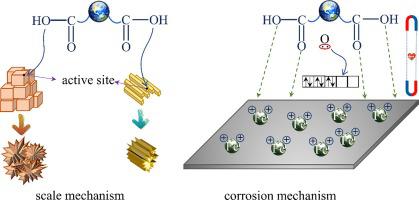Computational Materials Science ( IF 3.1 ) Pub Date : 2020-12-25 , DOI: 10.1016/j.commatsci.2020.110229 Xuesong Chen , Ying Chen , Jinjin Cui , Yuan Li , Yuning Liang , Guangsheng Cao

|
The environmental-friendly scale and corrosion inhibitors have been a hot topic in research. Four carboxylic acid type scale and corrosion inhibitors are introduced in this study, including polyaspartic acid (PASP), polyepoxysuccinic acid (PESA), oxidized starch (OS), and carboxymethyl cellulose (CMC). The scale and corrosion inhibition performance of PASP, PESA, OS, and CMC were investigated by molecular dynamics (MD) simulation and density functional theory (DFT) calculation. The interaction between the inhibitor and the surface of CaCO3 (1 1 0), CaCO3 (1 0 4), CaSO4 (0 2 0), and Fe (1 1 0) was explored with and without water, respectively. The results indicate that the binding energy of the inhibitor onto the surface of CaCO3 (1 1 0), CaCO3 (1 0 4), and CaSO4 (0 2 0) is as follows: PESA > PASP > OS > CMC. The binding energy onto the Fe (1 1 0) surface is: PASP > OS > CMC > PESA. It is worth noting that the influence of water molecules cannot be ignored. Besides, the global reactivity parameters of four inhibitors were also calculated to further explain the corrosion inhibition performance and mechanism, such as EHOMO, ELUMO, ΔE, χ.
中文翻译:

“绿色”水垢和缓蚀剂的分子动力学模拟和DFT计算
环保的阻垢剂和缓蚀剂一直是研究的热点。本研究介绍了四种羧酸型阻垢剂和缓蚀剂,包括聚天冬氨酸(PASP),聚环氧琥珀酸(PESA),氧化淀粉(OS)和羧甲基纤维素(CMC)。通过分子动力学(MD)模拟和密度泛函理论(DFT)计算,研究了PASP,PESA,OS和CMC的阻垢和缓蚀性能。分别在有水和无水条件下研究了抑制剂与CaCO 3(1 1 0),CaCO 3(1 0 4),CaSO 4(0 2 0)和Fe(1 1 0)表面之间的相互作用。结果表明抑制剂在CaCO 3表面的结合能(1 1 0),CaCO 3(1 0 4)和CaSO 4(0 2 0)如下:PESA> PASP> OS> CMC。在Fe(1 1 0)表面上的结合能为:PASP> OS> CMC> PESA。值得注意的是,水分子的影响不容忽视。此外,还计算了四种缓蚀剂的整体反应性参数,以进一步解释缓蚀性能和机理,如E HOMO,E LUMO,ΔE,χ。


















































 京公网安备 11010802027423号
京公网安备 11010802027423号